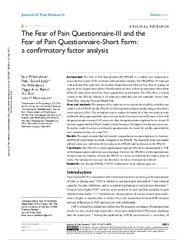| dc.contributor.advisor | Flaten, Magne Arve | |
| dc.contributor.author | Vambheim, Sara Magelssen | |
| dc.date.accessioned | 2018-11-19T12:04:57Z | |
| dc.date.available | 2018-11-19T12:04:57Z | |
| dc.date.issued | 2018-11-13 | |
| dc.description.abstract | The hypothesis that males are more responsive to placebo treatment than females was tested experimentally in this thesis. The hypothesis was confirmed and the results showed that the sex difference was related to a difference in males’ and females’ stress response after placebo treatment. Placebo responses on pain unpleasantness and the P2 component was found in males, but not in females.
The Fear of Pain Questionnaire-III (FPQ-III) and the Fear of Pain Questionnaire-Short Form (FPQ-SF) are two frequently used instruments that measure fear of pain in clinical and healthy samples. The second and third paper of this thesis examined sex differences in FOP, and model fit, reliability, validity and sex neutrality of these two models. It was expected that FOP would be higher in females than in males and that this would be shown as sex differences in overall FPQ-scores, subscale scores and at item level. Furthermore, it was hypothesized that the FPQ-SF would be preferred over the FPQ-III. The second paper uncovered higher fear of severe pain in females than in males, probably due to sex differences in psychological processes, such as fear and anxiety, and interpretation of fear of pain items. The third paper showed that neither the FPQ-III nor the FPQ-SF models had good fit to the data, although the FPQ-SF model was better suited than the FPQ-III overall and across sex subgroups. We therefore suggested adjustment of the present FOP-instruments. Our findings illustrate the importance of developing culture or country specific FOP models. | en_US |
| dc.description.doctoraltype | ph.d. | en_US |
| dc.description.popularabstract | The placebo analgesic effect is pain reduction after treatment with an inert substance or procedure, administered with suggestions of pain relief. Previous research has shown that placebo treatment produces larger pain reduction in males compared to females. We tested the hypothesis that males are more responsive to placebo treatment than females. The results showed that males were more responsive to placebo treatment and that the sex difference was related to a difference in males’ and females’ stress response after placebo treatment. Interestingly, the sex difference was reflected in EEG-measurements.
Pain is a multifaceted phenomenon, consisting of physiological, psychological and sociocultural components. Thus, it is important that clinical and experimental investigations of pain include psychosocial measures, such as measures of stress, anxiety and fear of pain. One widely used instrument for measurements of fear of pain is the Fear of Pain Questionnaire-III (FPQ-III). A more recent device, derived from the FPQ-III, is the Fear of Pain Questionnaire-Short Form (FPQ-SF). In two different studies we investigated sex differences in fear of pain and the applicability of the two abovementioned instruments. We expected that fear of pain would be higher in females than in males. We also expected that the more recent model, the FPQ-SF, would be better than the FPQ-III. The results uncovered higher fear of severe pain in females than in males. Possibly, this may have been due to sex differences in psychological processes, such as fear and anxiety, and interpretation of fear of pain items. The results also showed that neither the FPQ-III nor the FPQ-SF had good fit to the Norwegian data, but the FPQ-SF was better than the FPQ-III. Our findings illustrate the importance of validating and adjusting models for measurements of fear of pain. | en_US |
| dc.description.sponsorship | UiT - Norges arktiske universitet. The BIAL Foundation. | en_US |
| dc.identifier.uri | https://hdl.handle.net/10037/14210 | |
| dc.language.iso | eng | en_US |
| dc.publisher | UiT The Arctic University of Norway | en_US |
| dc.publisher | UiT Norges arktiske universitet | en_US |
| dc.relation.haspart | <p>Paper I: Aslaksen, P.M., Bystad, M., Vambheim, S.M. & Flaten, M.A. (2011). Gender Differences in Placebo Analgesia: Event-Related Potentials and Emotional Modulation. <i>Psychosomatic Medicine, 73</i>(2), 193-199. Full text not available due to publisher restrictions. Published version available at <a href=https://doi.org/10.1097/PSY.0b013e3182080d73> https://doi.org/10.1097/PSY.0b013e3182080d73. </a><p>
<p>Paper II: Vambheim, S.M. & Øien, R.A. (2017). Sex Differences in Fear of Pain: Item-Level Analysis of the Fear of Pain Questionnaire III. <i>Journal of Pain Research, 10</i>, 825-831. Also available at <a href=http://hdl.handle.net/10037/11112>http://hdl.handle.net/10037/11112. </a><p>
<p>Paper III: Vambheim, S.M., Lyby, P.S., Aslaksen, P.M., Flaten, M.A., Åsli, O. & Martinussen, L.M. (2017). The Fear of Pain Questionnaire-III and The Fear of Pain Questionnaire-Short Form: a confirmatory factor analysis. <i>Journal of Pain Research, 10</i>, 1871-1878. Also available at <a href=http://hdl.handle.net/10037/11828>http://hdl.handle.net/10037/11828. </a><p> | en_US |
| dc.rights.accessRights | openAccess | en_US |
| dc.rights.holder | Copyright 2018 The Author(s) | |
| dc.subject.courseID | DOKTOR-003 | |
| dc.subject | VDP::Samfunnsvitenskap: 200::Psykologi: 260::Kognitiv psykologi: 267 | en_US |
| dc.subject | VDP::Social science: 200::Psychology: 260::Cognitive psychology: 267 | en_US |
| dc.title | Sex differences in pain, fear of pain and placebo analgesia | en_US |
| dc.type | Doctoral thesis | en_US |
| dc.type | Doktorgradsavhandling | en_US |


 English
English norsk
norsk

